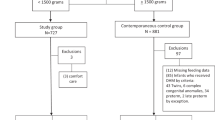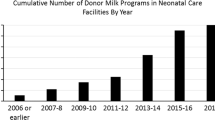Abstract
Objective:
To determine the effect of a dedicated lactation consultant (LC) on the percentage of neonates receiving any human milk in the neonatal intensive care unit (NICU) and at discharge over time.
Study Design:
Retrospective chart review of three time periods of 3 months each; Time period 1 (before LC hire), Time period 2 (T2; after LC arrival) and Time period 3 (subsequent period after T2).
Result:
Percentage of infants receiving any HM during hospital stay and at discharge increased significantly over time after LC hire and with LC experience. Outborn (OB) infants receiving any HM in the NICU and at discharge increased over time, but there was no significant change for inborn infants, as the proportion receiving any HM remained consistently high over time.
Conclusion:
Addition of a dedicated LC to the NICU increased the percentage of neonates receiving any HM, specifically in the OB population.
This is a preview of subscription content, access via your institution
Access options
Subscribe to this journal
Receive 12 print issues and online access
$259.00 per year
only $21.58 per issue
Buy this article
- Purchase on Springer Link
- Instant access to full article PDF
Prices may be subject to local taxes which are calculated during checkout



Similar content being viewed by others
References
American Academy of Pediatrics, Section on Breastfeeding. Breastfeeding and the use of human milk. Pediatrics 2005; 115: 496–506.
Aucott S, Donohue PK, Atkins E, Allen MC . Neurodevelopmental care in the NICU. Ment Retard Dev Disabil Res Rev 2002; 8: 298–308.
Hylander MA, Strobino DM, Dhanireddy R . Human milk feedings and infection among very low birth weight infants. Pediatrics 1998; 102: E38.
Baker BJ, Rasmussen TW . Organizing and documenting lactation support of NICU families. J Obstet Gynecol Neonatal Nurs 1997; 26: 515–521.
Bell EH, Geyer J, Jones L . A structured intervention improves breastfeeding success for ill or preterm infants. MCN Am J Matern Child Nurs 1995; 20: 309–314.
Furman L, Minich N, Hack M . Correlates of lactation in mothers of very low birth weight infants. Pediatrics 2002; 109: e57.
Meier PP, Engstrom JL, Mingolelli SS, Miracle DJ, Kiesling S . The Rush Mothers' Milk Club: breastfeeding interventions for mothers with very-low-birth-weight infants. J Obstet Gynecol Neonatal Nurs 2004; 33: 164–174.
Pinelli J, Atkinson SA, Saigal S . Randomized trial of breastfeeding support in very low-birth-weight infants. Arch Pediatr Adolesc Med 2001; 155: 548–553.
Furman L, Minich NM, Hack M . Breastfeeding of very low birth weight infants. J Hum Lact 1998; 14: 29–34.
Morton JA . Strategies to support extended breastfeeding of the premature infant. Adv Neonatal Care 2002; 2: 267–282.
Meier PP, Engstrom JL, Mangurten HH, Estrada E, Zimmerman B, Kopparthi R . Breastfeeding support services in the neonatal intensive-care unit. J Obstet Gynecol Neonatal Nurs 1993; 22: 338–347.
Gonzalez KA, Meinzen-Derr J, Burke BL, Hibler AJ, Kavinsky B, Hess S et al. Evaluation of a lactation support service in a children's hospital neonatal intensive care unit. J Hum Lact 2003; 19: 286–292.
Powers NG, Bloom B, Peabody J, Clark R . Site of care influences breast milk feedings at NICU discharge. J Perinatol 2003; 23: 10–13.
Clayton D, Hills M . Statistical Models in Epidemiolgy. Oxford University Press: Oxford, 1993.
Lawrence RA . Breastfeeding support benefits very low-birth-weight infants. Arch Pediatr Adolesc Med 2001; 155: 543–544.
Sikorski J, Renfrew MJ, Pindoria S, Wade A . Support for breastfeeding mothers: a systematic review. Paediatr Perinat Epidemiol 2003; 17: 407–417.
World Health Organization/UNICEF. Global Strategy for Infant and Young Child Feeding. World Health Organization: Geneva, 2003 pp. 7–8. http://www.who.int/child-adolescent-health/New_Publications/NUTRITION/gs_iycf.pdf.
DHHS. US Department of Health and Human Services. Healthy People 2010 2000, http://www.healthypeople.gov/document/html/objectives/16-19.htm.
Acknowledgements
We acknowledge the assistance of Susan Hailpern DrPH, MS. We thank Joshua C Brumberg PhD, Stephan F Brumberg EdD and Sergio G Golombek MD, MPH for helpful comments.
Author information
Authors and Affiliations
Corresponding author
Additional information
Supplementary Information accompanies the paper on the Journal of Perinatology website (http://www.nature.com/jp)
Supplementary information
Rights and permissions
About this article
Cite this article
Dweck, N., Augustine, M., Pandya, D. et al. NICU lactation consultant increases percentage of outborn versus inborn babies receiving human milk. J Perinatol 28, 136–140 (2008). https://doi.org/10.1038/sj.jp.7211888
Received:
Revised:
Accepted:
Published:
Issue Date:
DOI: https://doi.org/10.1038/sj.jp.7211888
Keywords
This article is cited by
-
Skilled lactation support using telemedicine in the neonatal intensive care unit
Journal of Perinatology (2024)



